1-Amino-2-methyl-4-bromoanthraquinone
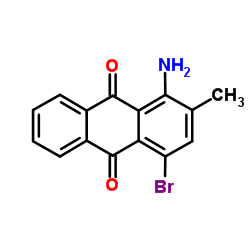
1-Amino-2-methyl-4-bromoanthraquinone structure
|
Common Name | 1-Amino-2-methyl-4-bromoanthraquinone | ||
|---|---|---|---|---|
| CAS Number | 81-50-5 | Molecular Weight | 316.149 | |
| Density | 1.6±0.1 g/cm3 | Boiling Point | 526.5±50.0 °C at 760 mmHg | |
| Molecular Formula | C15H10BrNO2 | Melting Point | 245ºC (dec.)(lit.) | |
| MSDS | USA | Flash Point | 272.2±30.1 °C | |
| Symbol |

GHS07 |
Signal Word | Warning | |
| Name | 1-amino-4-bromo-2-methylanthracene-9,10-dione |
|---|---|
| Synonym | More Synonyms |
| Density | 1.6±0.1 g/cm3 |
|---|---|
| Boiling Point | 526.5±50.0 °C at 760 mmHg |
| Melting Point | 245ºC (dec.)(lit.) |
| Molecular Formula | C15H10BrNO2 |
| Molecular Weight | 316.149 |
| Flash Point | 272.2±30.1 °C |
| Exact Mass | 314.989471 |
| PSA | 60.16000 |
| LogP | 4.93 |
| Vapour Pressure | 0.0±1.4 mmHg at 25°C |
| Index of Refraction | 1.706 |
Synonym: Section 2 - COMPOSITION, INFORMATION ON INGREDIENTS
Risk Phrases: 36/37/38 Section 3 - HAZARDS IDENTIFICATION EMERGENCY OVERVIEW
Irritating to eyes, respiratory system and skin. Potential Health Effects Eye: Causes eye irritation. Skin: Causes skin irritation. May be harmful if absorbed through the skin. Ingestion: May cause irritation of the digestive tract. May be harmful if swallowed. Inhalation: Causes respiratory tract irritation. May be harmful if inhaled. Chronic: Not available. Section 4 - FIRST AID MEASURES Eyes: Flush eyes with plenty of water for at least 15 minutes, occasionally lifting the upper and lower eyelids. Get medical aid. Skin: Get medical aid. Flush skin with plenty of water for at least 15 minutes while removing contaminated clothing and shoes. Ingestion: Get medical aid. Wash mouth out with water. Inhalation: Remove from exposure and move to fresh air immediately. If not breathing, give artificial respiration. If breathing is difficult, give oxygen. Get medical aid. Notes to Physician: Treat symptomatically and supportively. Section 5 - FIRE FIGHTING MEASURES General Information: As in any fire, wear a self-contained breathing apparatus in pressure-demand, MSHA/NIOSH (approved or equivalent), and full protective gear. Extinguishing Media: Use water spray, dry chemical, carbon dioxide, or chemical foam. Section 6 - ACCIDENTAL RELEASE MEASURES General Information: Use proper personal protective equipment as indicated in Section 8. Spills/Leaks: Vacuum or sweep up material and place into a suitable disposal container. Section 7 - HANDLING and STORAGE Handling: Avoid breathing dust, vapor, mist, or gas. Avoid contact with skin and eyes. Storage: Store in a cool, dry place. Store in a tightly closed container. Section 8 - EXPOSURE CONTROLS, PERSONAL PROTECTION Engineering Controls: Facilities storing or utilizing this material should be equipped with an eyewash facility and a safety shower. Use adequate ventilation to keep airborne concentrations low. Exposure Limits CAS# 81-50-5: Personal Protective Equipment Eyes: Not available. Skin: Wear appropriate protective gloves to prevent skin exposure. Clothing: Wear appropriate protective clothing to prevent skin exposure. Respirators: Follow the OSHA respirator regulations found in 29 CFR 1910.134 or European Standard EN 149. Use a NIOSH/MSHA or European Standard EN 149 approved respirator if exposure limits are exceeded or if irritation or other symptoms are experienced. Section 9 - PHYSICAL AND CHEMICAL PROPERTIES Physical State: Crystalline powder Color: orange to red Odor: Not available. pH: Not available. Vapor Pressure: Not available. Viscosity: Not available. Boiling Point: Not available. Freezing/Melting Point: 245 - 252 deg C Autoignition Temperature: Not available. Flash Point: Not available. Explosion Limits, lower: Not available. Explosion Limits, upper: Not available. Decomposition Temperature: Solubility in water: Specific Gravity/Density: Molecular Formula: C15H10BrNO2 Molecular Weight: 316.15 Section 10 - STABILITY AND REACTIVITY Chemical Stability: Not available. Conditions to Avoid: Incompatible materials. Incompatibilities with Other Materials: Strong oxidizing agents, strong acids. Hazardous Decomposition Products: Nitrogen oxides, carbon monoxide, carbon dioxide, hydrogen bromide. Hazardous Polymerization: Has not been reported Section 11 - TOXICOLOGICAL INFORMATION RTECS#: CAS# 81-50-5 unlisted. LD50/LC50: Not available. Carcinogenicity: 1-Amino-4-bromo-2-methylanthraquinone - Not listed by ACGIH, IARC, or NTP. Section 12 - ECOLOGICAL INFORMATION Section 13 - DISPOSAL CONSIDERATIONS Dispose of in a manner consistent with federal, state, and local regulations. Section 14 - TRANSPORT INFORMATION IATA Not regulated as a hazardous material. IMO Not regulated as a hazardous material. RID/ADR Not regulated as a hazardous material. Section 15 - REGULATORY INFORMATION European/International Regulations European Labeling in Accordance with EC Directives Hazard Symbols: XI Risk Phrases: R 36/37/38 Irritating to eyes, respiratory system and skin. Safety Phrases: S 26 In case of contact with eyes, rinse immediately with plenty of water and seek medical advice. S 37/39 Wear suitable gloves and eye/face protection. WGK (Water Danger/Protection) CAS# 81-50-5: No information available. Canada CAS# 81-50-5 is listed on Canada's NDSL List. CAS# 81-50-5 is not listed on Canada's Ingredient Disclosure List. US FEDERAL TSCA CAS# 81-50-5 is listed on the TSCA inventory. SECTION 16 - ADDITIONAL INFORMATION N/A |
| Symbol |

GHS07 |
|---|---|
| Signal Word | Warning |
| Hazard Statements | H315-H319-H335 |
| Precautionary Statements | P261-P305 + P351 + P338 |
| Personal Protective Equipment | dust mask type N95 (US);Eyeshields;Gloves |
| Hazard Codes | Xi: Irritant; |
| Risk Phrases | 36/37/38 |
| Safety Phrases | 26-37/39 |
| RIDADR | NONH for all modes of transport |
| WGK Germany | 3 |
| HS Code | 2922399090 |
|
~90% 
1-Amino-2-methy... CAS#:81-50-5 |
| Literature: Dynapol Patent: US4196294 A1, 1980 ; |
|
~% 
1-Amino-2-methy... CAS#:81-50-5 |
| Literature: US4051138 A1, ; |
|
~14% 
1-Amino-2-methy... CAS#:81-50-5 |
| Literature: Journal of Organic Chemistry USSR (English Translation), , vol. 27, # 8 p. 1547 - 1549 Zhurnal Organicheskoi Khimii, , vol. 27, # 8 p. 1762 - 1764 |
|
~85% 
1-Amino-2-methy... CAS#:81-50-5 |
| Literature: Gornostaev, L. M.; Sakilidi, V. T. Journal of Organic Chemistry USSR (English Translation), 1980 , vol. 16, # 3 p. 562 - 565 Zhurnal Organicheskoi Khimii, 1980 , vol. 16, # 3 p. 642 - 645 |
|
~% 
1-Amino-2-methy... CAS#:81-50-5 |
| Literature: DE612958 , ; Fortschr. Teerfarbenfabr. Verw. Industriezweige, vol. 20, p. 1304 |
|
~% 
1-Amino-2-methy... CAS#:81-50-5 |
| Literature: DE612958 , ; Fortschr. Teerfarbenfabr. Verw. Industriezweige, vol. 20, p. 1304 |
|
~% 
1-Amino-2-methy... CAS#:81-50-5 |
| Literature: DE612958 , ; Fortschr. Teerfarbenfabr. Verw. Industriezweige, vol. 20, p. 1304 |
| Precursor 5 | |
|---|---|
| DownStream 4 | |
| HS Code | 2922399090 |
|---|---|
| Summary | 2922399090 other amino-aldehydes, amino-ketones and amino-quinones, other than those containing more than one kind of oxygen function; salts thereof VAT:17.0% Tax rebate rate:9.0% Supervision conditions:none MFN tariff:6.5% General tariff:30.0% |
|
Structure-activity relationships of anthraquinone derivatives derived from bromaminic acid as inhibitors of ectonucleoside triphosphate diphosphohydrolases (E-NTPDases).
Purinergic Signal. 5(1) , 91-106, (2009) Reactive blue 2 (RB-2) had been characterized as a relatively potent ectonucleoside triphosphate diphosphohydrolase (E-NTPDase) inhibitor with some selectivity for NTPDase3. In search for the pharmaco... |
| Anthraquinone,1-amino-4-bromo-2-methyl |
| 9,10-Anthracenedione, 1-amino-4-bromo-2-methyl- |
| 1-Amino-4-brom-2-methyl-anthrachinon |
| 1-Amino-4-bromo-2-methyl-9,10-anthraquinone |
| 1-Amino-4-bromo-2-methylanthraquinone |
| EINECS 201-355-6 |
| 1-Amino-2-methyl-4-bromoanthraquinone |
| Anthraquinone, 1-amino-4-bromo-2-methyl- |
| 1-amino-4-bromo-2-methyl-9,10-anthracenedione |
| 9,10-Anthracenedione,1-amino-4-bromo-2-methyl |
| MFCD00001221 |
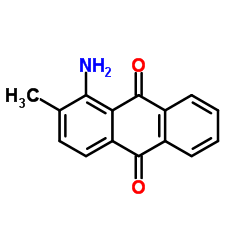

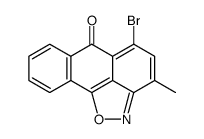



![N-(4-bromo-2-methyl-9-oxo-9,10-dihydro-[1]anthryl)-acetamide structure](https://image.chemsrc.com/caspic/370/860729-43-7.png)
![6-Bromo-1-carbethoxy-4-methyl-2, 7-dibenz[f,ij]isoquinoline-2,7-dione structure](https://image.chemsrc.com/caspic/208/51418-86-1.png) CAS#:51418-86-1
CAS#:51418-86-1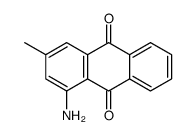 CAS#:10146-51-7
CAS#:10146-51-7![1-amino-2-methyl-4-[(4-methylphenyl)amino]anthraquinone structure](https://image.chemsrc.com/caspic/314/116-77-8.png) CAS#:116-77-8
CAS#:116-77-8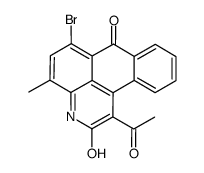 CAS#:63723-54-6
CAS#:63723-54-6